Harvest 2021 is almost here. It is a time when combine harvesters make their brief annual appearance before returning to hibernation for the larger part of the year.
It is likely that the largest portion of cereals harvested here in Ireland is combined by relatively modern machines, maybe 10 years old or younger.
That said, there are combine harvesters that are 30 and 40 years old or maybe even older that make an appearance on an annual basis during the harvest.
It is a bit of an unknown how many older “undocumented” combine harvesters there are out there.
Incomes
The fact remains that they are out there and help contribute to many farmers’ incomes.
Regardless of age, combine harvesters have a lot going on on-board and it pays to haul them out of the shed early and go through, at the very minimum, basic maintenance.
A good rule of thumb is to carry out deep maintenance, servicing and checks at least once every three years or annually on machines run by contractors and larger tillage farmer.
Maintenance on younger and larger machines would generally be carried out by the local dealer or combine specialist.
Older machines might not necessarily have access to the benefit of unfettered maintenance budgets.
With that in mind, a lot can be done, checks especially, without enormous mechanical experience. If in doubt about anything, ask. Get a second, preferably expert, opinion. Do not leave to chance.

John Deere T670i combine.
Repairs
Know the limit of your own mechanical abilities. It may be cheaper to pay for the repair first-off than pay for a double repair.
Quite a few manufacturers make their parts catalogues readily available online. Not just for newer combines, but for older legacy machines too.
This is a very useful resource for understanding how something is put together and what parts may be in an assembly.
New Holland, CaseIH, Claas and John Deere are among those that are easily accessible once you know where to look. For other brands, such as AGCO, you have to get your local dealer to register you for access.
Information
Information is key and the operator’s manual, if it can be found, provides enormous guidance in that regard.
Most machines will have stickers and guides located close to where adjustments are made.
Our weather is not always that accommodating, so checks and maintenance reduce the possibility of a breakdown and time lost harvesting.

Most machines will have a sticker outlining service intervals of particular components.
Aside from the inconvenience of a breakdown, one of the biggest risks to a combine harvester, its operator and everyone in close proximity to a ripe cereal field is fire.
The ignition temperature of straw is incredibly low and very easily set on fire by a failing bearing or slipping belt or clutch.
Factory on wheels

John Deere T670i combine.
Combine harvesters are like a factory on wheels; cutting the crop, transferring it to a drum where the straw and grain is separated before being processed even further to produce clean grain and rows of straw.
Regardless of combine age or size, that is what they all hope to achieve.
To do this, they rely on an enormous variety of chains, belts, bearings, pulleys, sprockets, hydraulics and electrical systems with a single engine driving the whole lot.
Rat damage
Where to start? Well, I like to drive a combine that has been in storage for the winter out into the open and park it on concrete.
Refit all covers, guards or plates that have been removed for the winter. Give the machine a start and check if all warning lights and warning systems activate and deactivate. If a warning alarm will not extinguish, then the source of that alarm needs to be extinguished.
In the picture above, a rat munched its way through nearly 30 wires under the dashboard console. There was a total loss of hydraulic functions and many, many other electrical warning and monitoring systems.
It there have been rodents munching on any elements of the harvester, it may well be worth investing in a box of mechanics’ gloves to minimise the risk of Weil’s disease.
Temperature
Clear the area of animals and spectators that could potentially or unintentionally come into contact with the harvester.
Yoke up the header and run the harvester on full threshing for a half hour or so at full threshing speed.
It is always good to have at least one other person to keep an eye on blind sides of the machine while it is running (and for potential machine trouble).
A simple infrared non-contact thermometer like this one (right) costs between €50 and €100.
With the harvester stopped and shut down, aim the infrared thermometer at every bearing and belt you can see to seek out heating components.
This is a quick and safe way to check for potential problems or failures and to rectify them before they happen.
Header

A smooth crop flow through the combine is essential.
A smooth crop flow through the combine is essential for even, consistent threshing.
Uneven crop flow and increased grain losses can overload the drive train and reduce harvesting capacity.
The header is where the crop begins its journey through the combine and aside from crop conditions, it can take very little to disrupt the crop flow through the combine.
Broken reel fingers, damaged knife sections and damaged or missing auger fingers can all contribute to poor crop flow and capacity.
Worth noting is that most auger heights and auger finger pitches plus reel finger pitches are adjustable if there are header issues with uneven feed of the crop to the centre of the auger.
Neck
The neck chain transfers the crop from the header to the harvester drum. Again, check that neck chain is adjusted according to the manufacturer’s instructions.
If it is too loose, there is a risk that the chains will jump off the sprockets.
Replace or straighten any damaged slats. If a slat is bent, it will cause premature neck chain wear and failure. It is not a nice job to replace and is an unnecessary cost.
Rasp bars
The vast majority of crop threshing is carried out by the drum and concave.
The condition of both will affect how effective a combine is at threshing. Damaged (usually by stones) or worn drum or concave greatly reduce combine harvesting capacity and the quality of the threshed grain sample.
Look out for rounded or damaged concave bars plus damaged wires in the concave. Worn or bent rasp bars also reduce machine capacity.
Grain pan
The grain pan and separation area needs to be checked for damage to the stepped transfer pan behind the concave and adjustable frog-mouth sieves towards the rear of the machine.
They get a lot of moving and shaking in their life which can literally rattle them to bits. Inspect the flat rubber seals between the shaker shoe and the inner side walls of the combine.
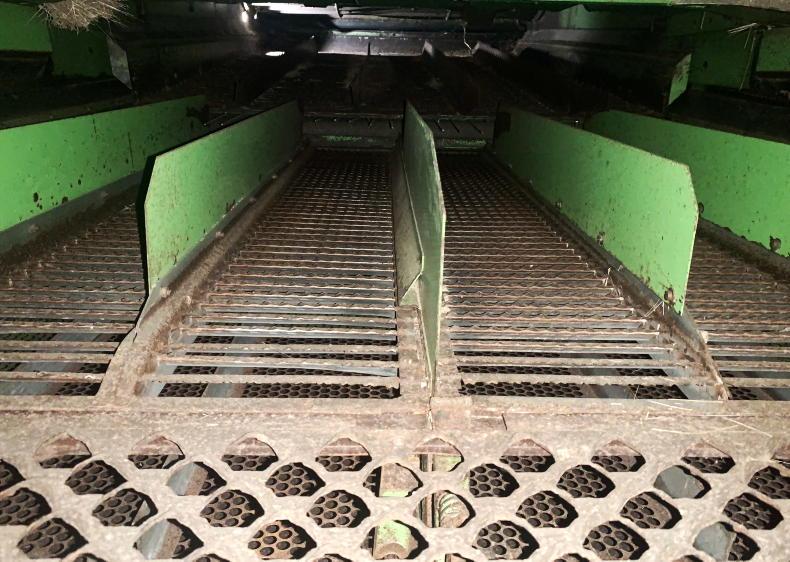
The grain pan and separation area needs to be checked for damage.
A dietary favourite among rodents and a massive source of grain loss if damaged. The entire grain separation unit – shaker shoe - is usually suspended on either rubber bearings or roller bearings.
Again, these need to be checked for wear, especially the rubber versions.
Grain elevator
Moving the grain from the bottom of the shaker shoe to the grain tank is a grain elevator.
Many machines have a second elevator for returning unthreshed grain to the threshing drum.
All need to be inspected for damage to the rubber paddles that transfer the grain. Again, another rodent favourite.
This chain often requires adjustment. Best practice is to follow the operator’s manual instructions (you should be just about able to move the chain sideways on the bottom sprocket).
Up in the grain tank, there may be a bubble-up auger which needs to be checked too.
Walkers
The straw walkers are subject to a pretty tough life too.
Some have timber bearings like these and others have bearings.
There should be no play in the walkers. Inspect for rust and cracks too.
Drive belt
There is no shortage of drive belts, chains and gearboxes on most combine harvesters. This belt has clearly reached the end of its life and will need replacing.
Some are straightforward to change. Others, like those in variable-speed drives such as the drum or separation fan, are more complex.
These are even dangerous to change if you don’t know what you’re doing, so best leave to the experts. Inspect chain drives for correct adjustment.
It the correct adjustment cannot be achieved, then the chain may be worn to the point where it needs replacing before it breaks.
Gearbox and final drive
There may be gearboxes for auger drive, final drive at the wheels and transmission in mechanical drive versions. All need to be checked for gear oil level.
Low or dirty, milky oil may indicate a problem that needs rectifying before it becomes an even bigger or more expensive problem.
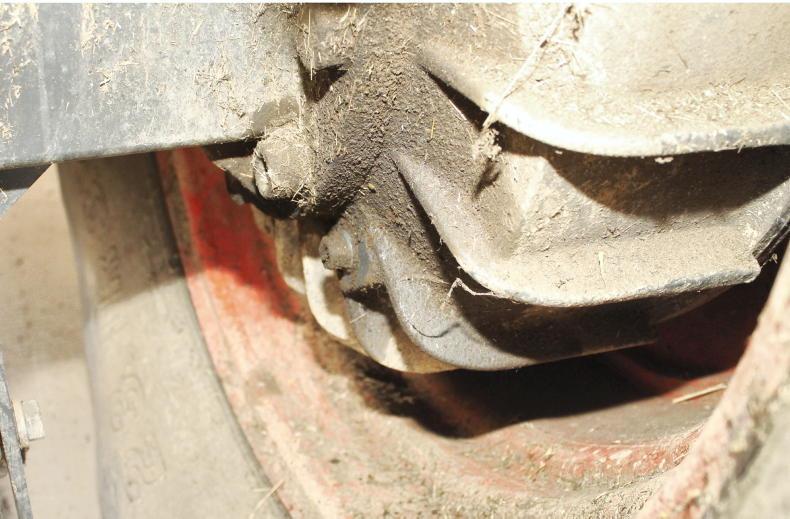
Ensure all gearboxes and final drives have the correct level of oil.
Engine
With a machine that spends 80% of its life effectively sleeping and the remaining 20% working flat out, it really is important to have the engine serviced, changing the oil and all filters (blow out air if it looks ok).
Don’t forget to have all fuel filters changed to minimise any potential fuel issues. There may be other filters too for hydraulics and drivetrain. Check all oil and coolant levels plus engine fan belts.
Cooling package
Hot, dusty conditions are a tough environment for combine harvesters to work in.
And throw in a hill plus a high-yielding crop, then keeping cool can be a challenge.
Blow out all radiators with compressed air (not a power washer) before the season starts and make sure that any devices such as rotary screens are functioning. Use a long lance or work platform if required to carry out the task safely.
Cab
If you are lucky enough to have a cab fitted and it’s a modern one with air conditioning (AC), don’t forget to clean or replace the cab filters. The air conditioning needs air passing through it to do its job.
The AC may need recharging if it’s not producing enough chill.
Run through all the lights and beacons to make sure they work. Don’t forget the wiper too – hopefully it won’t be needed.
Ken Graham Engineering Ltd; Combine Parts; www.kengrahameng.com; 057-862 5154.
Roto Spiral Ltd; Auger manufacture; www.rotospiral.ie; 056-776 8619.
Andy Byrne – Byrnes of Ballytarsna; New and used combine parts; 053-942 6848.
Bernard Byrne Combines Ltd; New and used Combine parts; www.bernardbyrnecombines.com; 053-942 6390.
F Jenkinson Limited; Combine parts; www.fjenkinson.ie; 059-972 7192.
Harvest 2021 is almost here. It is a time when combine harvesters make their brief annual appearance before returning to hibernation for the larger part of the year.
It is likely that the largest portion of cereals harvested here in Ireland is combined by relatively modern machines, maybe 10 years old or younger.
That said, there are combine harvesters that are 30 and 40 years old or maybe even older that make an appearance on an annual basis during the harvest.
It is a bit of an unknown how many older “undocumented” combine harvesters there are out there.
Incomes
The fact remains that they are out there and help contribute to many farmers’ incomes.
Regardless of age, combine harvesters have a lot going on on-board and it pays to haul them out of the shed early and go through, at the very minimum, basic maintenance.
A good rule of thumb is to carry out deep maintenance, servicing and checks at least once every three years or annually on machines run by contractors and larger tillage farmer.
Maintenance on younger and larger machines would generally be carried out by the local dealer or combine specialist.
Older machines might not necessarily have access to the benefit of unfettered maintenance budgets.
With that in mind, a lot can be done, checks especially, without enormous mechanical experience. If in doubt about anything, ask. Get a second, preferably expert, opinion. Do not leave to chance.

John Deere T670i combine.
Repairs
Know the limit of your own mechanical abilities. It may be cheaper to pay for the repair first-off than pay for a double repair.
Quite a few manufacturers make their parts catalogues readily available online. Not just for newer combines, but for older legacy machines too.
This is a very useful resource for understanding how something is put together and what parts may be in an assembly.
New Holland, CaseIH, Claas and John Deere are among those that are easily accessible once you know where to look. For other brands, such as AGCO, you have to get your local dealer to register you for access.
Information
Information is key and the operator’s manual, if it can be found, provides enormous guidance in that regard.
Most machines will have stickers and guides located close to where adjustments are made.
Our weather is not always that accommodating, so checks and maintenance reduce the possibility of a breakdown and time lost harvesting.

Most machines will have a sticker outlining service intervals of particular components.
Aside from the inconvenience of a breakdown, one of the biggest risks to a combine harvester, its operator and everyone in close proximity to a ripe cereal field is fire.
The ignition temperature of straw is incredibly low and very easily set on fire by a failing bearing or slipping belt or clutch.
Factory on wheels

John Deere T670i combine.
Combine harvesters are like a factory on wheels; cutting the crop, transferring it to a drum where the straw and grain is separated before being processed even further to produce clean grain and rows of straw.
Regardless of combine age or size, that is what they all hope to achieve.
To do this, they rely on an enormous variety of chains, belts, bearings, pulleys, sprockets, hydraulics and electrical systems with a single engine driving the whole lot.
Rat damage
Where to start? Well, I like to drive a combine that has been in storage for the winter out into the open and park it on concrete.
Refit all covers, guards or plates that have been removed for the winter. Give the machine a start and check if all warning lights and warning systems activate and deactivate. If a warning alarm will not extinguish, then the source of that alarm needs to be extinguished.
In the picture above, a rat munched its way through nearly 30 wires under the dashboard console. There was a total loss of hydraulic functions and many, many other electrical warning and monitoring systems.
It there have been rodents munching on any elements of the harvester, it may well be worth investing in a box of mechanics’ gloves to minimise the risk of Weil’s disease.
Temperature
Clear the area of animals and spectators that could potentially or unintentionally come into contact with the harvester.
Yoke up the header and run the harvester on full threshing for a half hour or so at full threshing speed.
It is always good to have at least one other person to keep an eye on blind sides of the machine while it is running (and for potential machine trouble).
A simple infrared non-contact thermometer like this one (right) costs between €50 and €100.
With the harvester stopped and shut down, aim the infrared thermometer at every bearing and belt you can see to seek out heating components.
This is a quick and safe way to check for potential problems or failures and to rectify them before they happen.
Header

A smooth crop flow through the combine is essential.
A smooth crop flow through the combine is essential for even, consistent threshing.
Uneven crop flow and increased grain losses can overload the drive train and reduce harvesting capacity.
The header is where the crop begins its journey through the combine and aside from crop conditions, it can take very little to disrupt the crop flow through the combine.
Broken reel fingers, damaged knife sections and damaged or missing auger fingers can all contribute to poor crop flow and capacity.
Worth noting is that most auger heights and auger finger pitches plus reel finger pitches are adjustable if there are header issues with uneven feed of the crop to the centre of the auger.
Neck
The neck chain transfers the crop from the header to the harvester drum. Again, check that neck chain is adjusted according to the manufacturer’s instructions.
If it is too loose, there is a risk that the chains will jump off the sprockets.
Replace or straighten any damaged slats. If a slat is bent, it will cause premature neck chain wear and failure. It is not a nice job to replace and is an unnecessary cost.
Rasp bars
The vast majority of crop threshing is carried out by the drum and concave.
The condition of both will affect how effective a combine is at threshing. Damaged (usually by stones) or worn drum or concave greatly reduce combine harvesting capacity and the quality of the threshed grain sample.
Look out for rounded or damaged concave bars plus damaged wires in the concave. Worn or bent rasp bars also reduce machine capacity.
Grain pan
The grain pan and separation area needs to be checked for damage to the stepped transfer pan behind the concave and adjustable frog-mouth sieves towards the rear of the machine.
They get a lot of moving and shaking in their life which can literally rattle them to bits. Inspect the flat rubber seals between the shaker shoe and the inner side walls of the combine.

The grain pan and separation area needs to be checked for damage.
A dietary favourite among rodents and a massive source of grain loss if damaged. The entire grain separation unit – shaker shoe - is usually suspended on either rubber bearings or roller bearings.
Again, these need to be checked for wear, especially the rubber versions.
Grain elevator
Moving the grain from the bottom of the shaker shoe to the grain tank is a grain elevator.
Many machines have a second elevator for returning unthreshed grain to the threshing drum.
All need to be inspected for damage to the rubber paddles that transfer the grain. Again, another rodent favourite.
This chain often requires adjustment. Best practice is to follow the operator’s manual instructions (you should be just about able to move the chain sideways on the bottom sprocket).
Up in the grain tank, there may be a bubble-up auger which needs to be checked too.
Walkers
The straw walkers are subject to a pretty tough life too.
Some have timber bearings like these and others have bearings.
There should be no play in the walkers. Inspect for rust and cracks too.
Drive belt
There is no shortage of drive belts, chains and gearboxes on most combine harvesters. This belt has clearly reached the end of its life and will need replacing.
Some are straightforward to change. Others, like those in variable-speed drives such as the drum or separation fan, are more complex.
These are even dangerous to change if you don’t know what you’re doing, so best leave to the experts. Inspect chain drives for correct adjustment.
It the correct adjustment cannot be achieved, then the chain may be worn to the point where it needs replacing before it breaks.
Gearbox and final drive
There may be gearboxes for auger drive, final drive at the wheels and transmission in mechanical drive versions. All need to be checked for gear oil level.
Low or dirty, milky oil may indicate a problem that needs rectifying before it becomes an even bigger or more expensive problem.

Ensure all gearboxes and final drives have the correct level of oil.
Engine
With a machine that spends 80% of its life effectively sleeping and the remaining 20% working flat out, it really is important to have the engine serviced, changing the oil and all filters (blow out air if it looks ok).
Don’t forget to have all fuel filters changed to minimise any potential fuel issues. There may be other filters too for hydraulics and drivetrain. Check all oil and coolant levels plus engine fan belts.
Cooling package
Hot, dusty conditions are a tough environment for combine harvesters to work in.
And throw in a hill plus a high-yielding crop, then keeping cool can be a challenge.
Blow out all radiators with compressed air (not a power washer) before the season starts and make sure that any devices such as rotary screens are functioning. Use a long lance or work platform if required to carry out the task safely.
Cab
If you are lucky enough to have a cab fitted and it’s a modern one with air conditioning (AC), don’t forget to clean or replace the cab filters. The air conditioning needs air passing through it to do its job.
The AC may need recharging if it’s not producing enough chill.
Run through all the lights and beacons to make sure they work. Don’t forget the wiper too – hopefully it won’t be needed.
Ken Graham Engineering Ltd; Combine Parts; www.kengrahameng.com; 057-862 5154.
Roto Spiral Ltd; Auger manufacture; www.rotospiral.ie; 056-776 8619.
Andy Byrne – Byrnes of Ballytarsna; New and used combine parts; 053-942 6848.
Bernard Byrne Combines Ltd; New and used Combine parts; www.bernardbyrnecombines.com; 053-942 6390.
F Jenkinson Limited; Combine parts; www.fjenkinson.ie; 059-972 7192.












 This is a subscriber-only article
This is a subscriber-only article





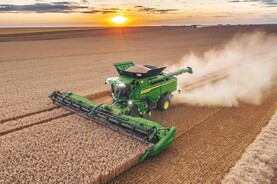
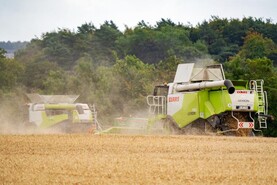

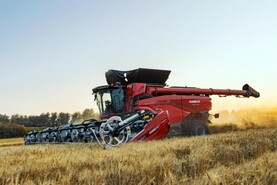
SHARING OPTIONS: